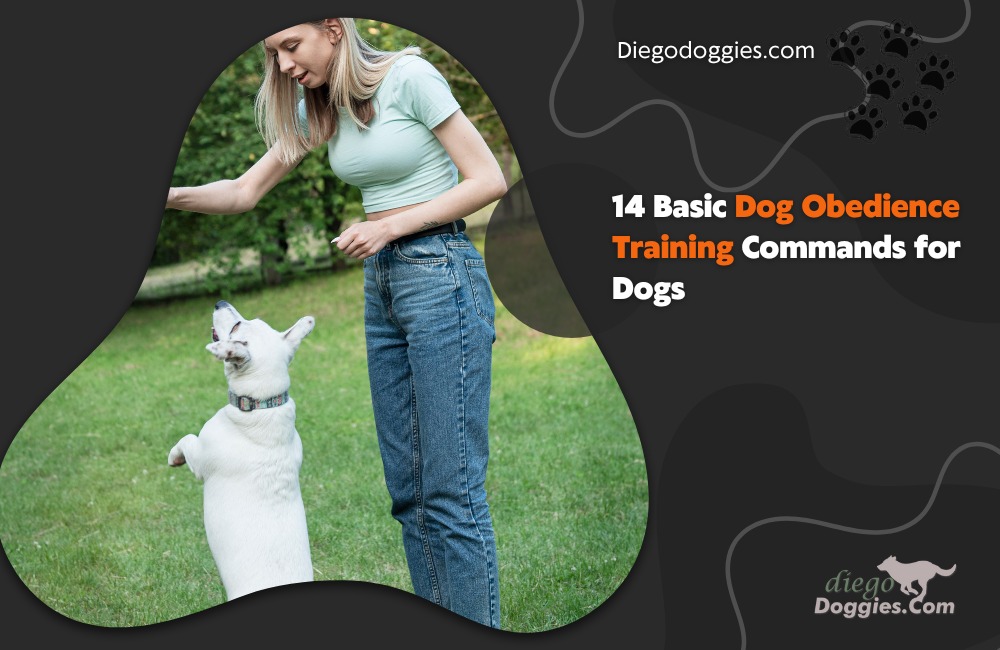If you are a dog owner, dog obedience training is a must. It can be challenging to train your dog yourself, but it is worth the effort. In this blog post, we will discuss the 14 basic obedience commands that every dog should know. We’ll provide tips on how to train your dog and what to do if he or she starts to disobey. Let’s get started!

Obedience Training Equipment
The first thing you’ll need for obedience training is a good set of equipment. This includes a leash, collar, and harness. You’ll also need some tasty treats that your dog loves. Training takes patience and consistency, so be prepared to put in the time and effort.
Types Of Obedience Training Classes
There are several different types of obedience training classes available for dogs and their owners. The most basic type of class is the puppy class, which is designed to socialize young dogs and teach them basic obedience commands such as sit, stay, come, and down. Puppy classes typically meet once or twice a week for one-hour sessions.
Other types of obedience training classes include the basic obedience class, which is designed to teach dogs the same commands as the puppy class but in a more formal setting. Basic obedience classes typically meet once or twice a week for one-hour sessions.
Advanced obedience training classes are available for dogs who have already mastered the basics and are ready to learn more advanced commands. Advanced obedience classes typically meet once or twice a week for one-hour sessions.
Competition obedience training classes are available for dogs who will be competing in obedience trials. These classes typically meet once or twice a week for one-hour sessions.
Obedience training is an important part of owning a dog and can provide both you and your dog with a lifetime of enjoyment. Whether you choose to take a class or train your dog on your own, the most important thing is to be patient, consistent, and have fun!
There are many obedience training schools that use different approaches. Some employ positive reinforcement while others prefer negative reinforcement. It is best to ask around and see what other dog owners recommend. You may also want to read online reviews before enrolling your dog in a particular class.

No matter which type of obedience training you choose, the most important thing is to be patient, consistent, and have fun! Some of these commands, such as sit, stay, come, and down, are self-explanatory. Others, like heel and leave it, may require a bit more explanation.
We’ll go into detail about each of these commands below.
1. Sit: This is probably the most basic obedience command that you can teach your dog. To train your dog to sit, start by getting him or her in a standing position. Then, hold a treat close to his or her nose and say “sit.” As your dog smells the treat, he or she will likely start to sit down.
Once your dog’s bottom hits the ground, give him or her the treat and praise. Repeat this process until your dog is consistently sitting on command.
2. Stay: The stay command is important for teaching your dog patience and self-control. To train your dog to stay, start by getting him or her in a sitting or standing position. Then, give the command “stay” and take one step back. If your dog stays in place, give him or her a treat and praise.
If your dog gets up and follows you, simply guide him or her back to the original spot and try again. Repeat this process until your dog is consistently staying in place on command.
3. Come: The come command is a great way to recall your dog when he or she is off-leash. To train your dog to come, start by getting him or her in a sitting or standing position. Then, call his or her name and say “come.”
As your dog comes toward you, give him or her a treat and praise. If your dog does not come when called, simply try again. Repeat this process until your dog is consistently coming when called.
4. Down: The down command is another great way to teach your dog patience and self-control. To train your dog to down, start by getting him or her in a sitting position. Then, hold a treat close to his or her nose and say “down.”
As your dog smells the treat, he or she will likely start to lie down. Once your dog is lying down, give him or her the treat and praise. Repeat this process until your dog is consistently lying down on command.
5. Heel: The heel command is important for teaching your dog to walk politely on a leash. To train your dog to heel, start by getting him or her in a sitting position. Then, put a leash on and say “heel.” As you start to walk, your dog will likely follow behind you.
If he or she starts to pull ahead, simply stop and wait until he or she gets back into position. Once your dog is walking politely by your side, give him or her a treat and praise. Repeat this process until your dog consistently heels on command.
6. Leave it: The leave it commands is important for teaching your dog not to touch things that are not his or hers. To train your dog to leave it, start by getting him or her in a sitting position. Then, hold a treat close to his or her nose and say, “leave it.” As your dog smells the treat, he or she will likely start to reach for it.
However, do not give the treat to your dog until he or she has stopped reaching for it and is sitting or standing calmly. Once your dog is sitting or standing calmly, give him or her the treat and praise. Repeat this process until your dog is consistently leaving things alone on command.
7. Drop it: The drop it commands is important for teaching your dog to let go of things that he or she is holding. To train your dog to drop it, start by getting him or her in a sitting position. Then, hold a treat close to his or her nose and say, “drop it.” As your dog smells the treat, he or she will likely start to reach for it.
However, do not give the treat to your dog until he or she has let go of the object and is sitting or standing calmly. Once your dog is sitting or standing calmly, give him or her the treat and praise. Repeat this process until your dog is consistently dropping things on command.
8. Watch me: The watch me command is a great way to get your dog’s attention. To train your dog to watch you, start by getting him or her in a sitting position. Then, say “watch me” and wait for your dog to make eye contact with you. Once your dog makes eye contact, give him or her a treat and praise.
If your dog does not make eye contact, simply try again. Repeat this process until your dog is consistently making eye contact on command.
9. Wait: The wait command is important for teaching your dog patience and self-control. To train your dog to wait, start by getting him or her in a sitting position. Then, hold a treat close to his or her nose and say “wait.” As your dog smells the treat, he or she will likely start to reach for it.
10. Shake: The shake command is a fun way to show off your dog’s tricks. To train your dog to shake, start by getting him or her in a sitting position. Then, offer your hand and say “shake.”
As your dog smells your hand, he or she will likely start to paw at it. Once your dog paws at your hand, give him or her a treat and praise. Repeat this process until your dog is consistently shaking on command.
11. Rollover: The rollover command is a fun way to show off your dog’s tricks. To train your dog to roll over, start by getting him or her in a lying-down position. Then, hold a treat close to his or her nose and say, “roll over.”
As your dog smells the treat, he or she will likely start to roll over. Once your dog rolls over, give him or her the treat and praise. Repeat this process until your dog is consistently rolling over on command.
12. Speak: The speak command is a fun way to show off your dog’s tricks. To train your dog to speak, start by getting him or her in a sitting position. Then, hold a treat close to his or her nose and say “speak.”
As your dog smells the treat, he or she will likely start to bark. Once your dog starts barking, give him or her the treat and praise. Repeat this process until your dog is consistently speaking on command.
13. Touch: The touch command is a great way to get your dog’s attention. To train your dog to touch, start by getting him or her in a sitting position. Then, hold a treat close to his or her nose and say “touch.” As your dog smells the treat, he or she will likely start to paw at it.
Once your dog paws at your hand, give him or her the treat and praise. Repeat this process until your dog is consistently touching on command.
14. Take it: The take it commands is important for teaching your dog to pick up things gently. To train your dog to take it, start by getting him or her in a sitting position. Then, hold a treat close to his or her nose and say, “take it.” As your dog smells the treat, he or she will likely start to reach for it.
However, do not give the treat to your dog until he or she has taken the object gently and is sitting or standing calmly. Once your dog is sitting or standing calmly, give him or her the treat and praise. Repeat this process until your dog is consistently taking things on command.
Conclusion
Obedience training is important for several reasons. It helps your dog to understand what is expected of him or her, and it can help to prevent problem behaviors from developing. Dogs who are well-trained are typically more confident and happier than those who are not, so it’s in your dog’s best interest to learn obedience commands.
These are just a few of the basic obedience commands that you can teach your dog. By consistently practicing these commands, you can help your dog become a well-behaved member of the family.
Related Contents
- 14 Easy Ways to Exercise Your Dog: Fun and Effective Methods
- 8 Therapy Dog Training Tips: How to Train Your Dog
- How Much Does Dog Training Cost? A Comprehensive Guide
- How to Make Crate Training Easy for Your Puppy
- How to Stop a Dog Chewing Everything
- How to Stop a Puppy from Biting You
- How to Stop Your Dog from Being Aggressive To Strangers
- How to Teach a Dog to Smile: Fun and Easy Tips
- How to Train a Big Dog: Tips for Effective Obedience Training
- How to Train Your Dog to Roll Over in 7 Easy Steps
- Important Essential Training Tools for Dogs
- San Diego Dog Park Safety Tips, Training, and Dog Accessories
- Seven Top Tips: How to Train Your Dog to Hunt


11 thoughts on “14 Basic Dog Obedience Training Commands for Dogs”